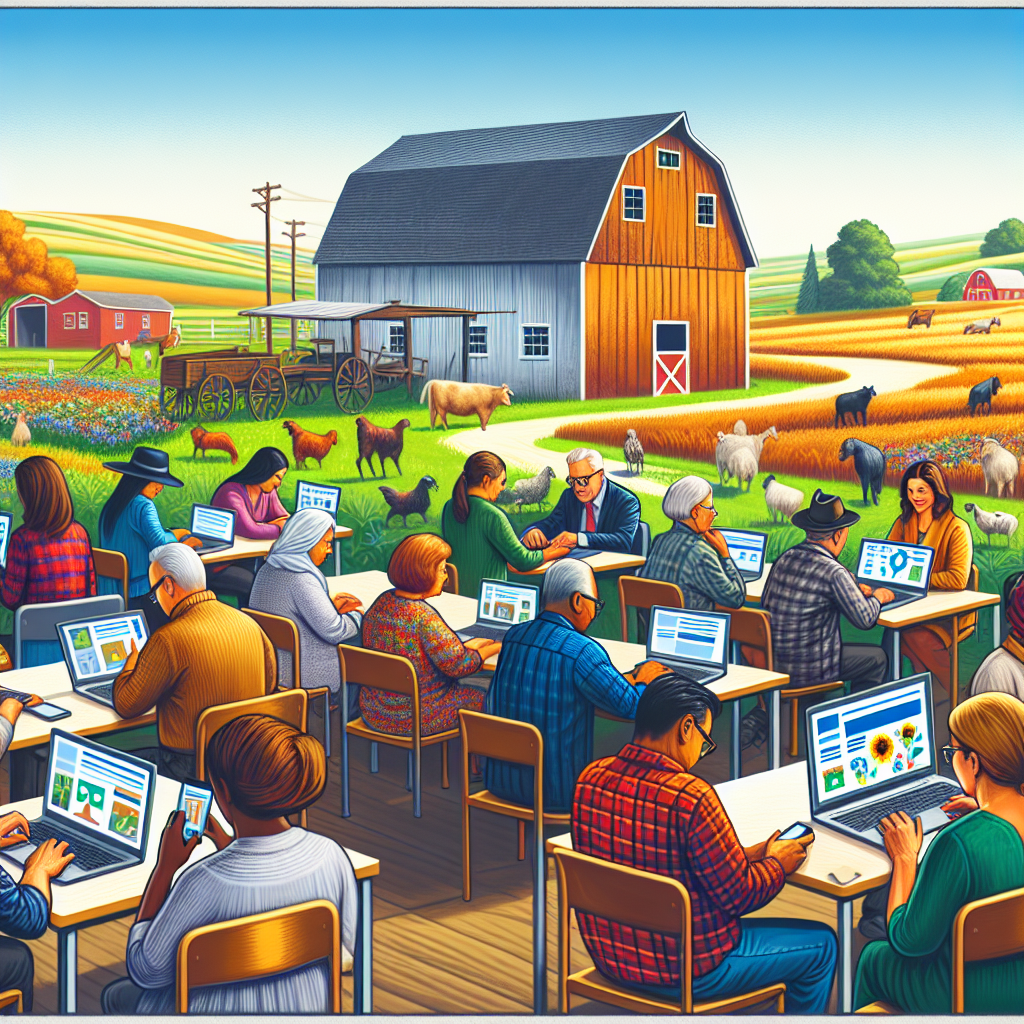In today’s increasingly digital world, access to technology and digital skills is crucial for success. However, in many rural areas of America, there is a significant digital divide that prevents residents from fully participating in the digital economy. Community-based digital literacy initiatives have emerged as a solution to bridge this gap, offering education and training to underserved populations. These programs not only provide individuals with the skills they need to thrive in the digital age, but also foster a sense of community and empowerment. Join us as we explore the impactful outcomes of these initiatives in rural America, and uncover the transformative effects they have on individuals and communities alike.
Understanding Community-Based Digital Literacy Initiatives
In the realm of community-based digital literacy initiatives, a key aspect to grasp is the definition of digital literacy itself. Digital literacy encompasses the ability to access, evaluate, and utilize information effectively using digital technologies. It goes beyond basic technical skills to include critical thinking, problem-solving, and ethical considerations in the digital world.
The significance of digital literacy in contemporary society cannot be overstated. In today’s increasingly digitalized world, digital literacy is a fundamental skill that empowers individuals to navigate the complexities of the digital landscape. From online communication and information retrieval to digital security and online collaboration, digital literacy is crucial for full participation in the modern economy and society.
Community-based digital literacy initiatives play a pivotal role in promoting digital literacy within rural America. These initiatives are grassroots efforts that aim to bridge the digital divide and empower community members with the necessary skills and knowledge to thrive in the digital age. By leveraging local resources, expertise, and networks, community-based initiatives tailor digital literacy programs to meet the specific needs and challenges faced by rural populations.
Overall, community-based digital literacy initiatives serve as catalysts for digital inclusion and empowerment in rural America. They not only equip individuals with the digital skills needed for success but also foster a sense of community engagement and collaboration in harnessing the benefits of digital technologies.
The Role of Community Organizations
Community organizations play a pivotal role in driving digital literacy initiatives in rural America through strategic collaborations and proactive engagement. By partnering with local schools and libraries, these organizations create a network of support for individuals seeking to enhance their digital skills in the community. This partnership facilitates access to resources, training programs, and technology infrastructure, thereby bridging the digital divide prevalent in rural areas.
Moreover, community organizations actively engage with local businesses to tailor digital literacy programs that address the specific needs and demands of the workforce. By understanding the digital requirements of businesses operating in rural America, these initiatives can effectively equip individuals with the necessary skills to thrive in the digital economy. Through workshops, mentorship programs, and hands-on training sessions, community organizations empower community members to leverage digital tools for personal and professional growth.
Additionally, community centers serve as focal points for hosting digital literacy programs and workshops, providing a centralized location for individuals to access training and resources. These centers act as hubs for innovation and collaboration, fostering a supportive environment where community members can learn from each other and collectively enhance their digital proficiency. By utilizing these community spaces effectively, organizations can maximize the reach and impact of digital literacy initiatives, ensuring that no individual is left behind in the digital transformation sweeping rural America.
Target Audience and Accessibility
Understanding Community-Based Digital Literacy Initiatives
- Identifying the digital divide in rural areas:
- Rural communities often face challenges in accessing digital literacy resources due to limited infrastructure and resources.
-
Targeting specific demographics within rural areas such as seniors, low-income families, and minority groups can help address the digital divide more effectively.
-
Tailoring programs to meet the needs of diverse populations:
- Understanding the unique challenges and preferences of different rural populations is crucial in designing effective digital literacy initiatives.
-
Customizing programs to cater to varying levels of digital literacy proficiency and learning styles can enhance the impact of community-based initiatives.
-
Overcoming barriers to access digital literacy resources:
- Lack of internet connectivity and limited access to devices are common barriers in rural areas that impede digital literacy initiatives.
- Collaborating with local organizations, providing mobile learning opportunities, and offering incentives can help overcome these accessibility challenges and ensure the success of digital literacy programs in rural America.
Assessing the Effectiveness of Community-Based Initiatives

Tracking and Measuring Impact
In assessing the effectiveness of community-based digital literacy initiatives in rural America, it is crucial to establish robust tracking and measurement mechanisms. This involves implementing quantitative and qualitative data collection methods to gauge the initiatives’ impact on rural residents’ digital skills and overall empowerment. Tracking metrics such as the number of participants, the frequency of engagement, and the types of skills acquired can provide valuable insights into the initiatives’ reach and effectiveness. Additionally, measuring changes in participants’ confidence levels in using digital tools and accessing online resources can offer a more nuanced understanding of the initiatives’ impact on individual empowerment.
Success Stories from Rural Communities
Sharing success stories from rural communities that have benefited from digital literacy initiatives can serve as compelling evidence of their effectiveness. By highlighting specific cases where individuals have improved their digital skills, found new educational or employment opportunities, or enhanced their quality of life through increased digital access, these success stories can showcase the tangible benefits of community-based initiatives. Moreover, success stories can inspire other rural residents to engage with digital literacy programs and demonstrate the transformative potential of such initiatives in bridging the digital divide in rural America.
Challenges and Opportunities for Improvement
While community-based digital literacy initiatives in rural America have shown promise in enhancing residents’ digital skills and connectivity, they also face significant challenges and opportunities for improvement. Some common challenges include limited access to high-speed internet infrastructure in rural areas, inadequate funding for sustaining initiatives long-term, and barriers to engaging hard-to-reach populations, such as elderly or marginalized community members. Addressing these challenges requires collaborative efforts among stakeholders, including government agencies, nonprofit organizations, and local community leaders, to develop innovative solutions and secure resources to support ongoing digital literacy efforts. Moreover, seizing opportunities for improvement, such as expanding partnerships with local schools, libraries, and businesses, can enhance the scalability and sustainability of community-based digital literacy initiatives in rural America.
Empowering Individuals Through Skills Development
In community-based digital literacy initiatives in rural America, empowering individuals through skills development is a crucial component aimed at bridging the digital divide and enhancing overall wellbeing. This section delves into the specific strategies employed to empower individuals in these initiatives.
- Building Basic Digital Skills
- Participants are introduced to fundamental digital skills such as navigating the internet, using email, and creating documents.
- Structured courses and hands-on workshops are designed to cater to varying skill levels, ensuring that individuals at any stage of digital literacy can benefit.
-
Emphasis is placed on practical applications to ensure that individuals can confidently apply their newfound skills in real-world scenarios.
-
Promoting Online Safety and Security
- Education on recognizing and avoiding online threats such as phishing scams, malware, and identity theft is integrated into the curriculum.
- Participants are taught best practices for creating secure passwords, safeguarding personal information, and identifying reputable sources online.
-
Interactive sessions and simulations are utilized to simulate real online risks and teach individuals how to protect themselves effectively.
-
Enhancing Job Readiness Through Digital Literacy Training
- Job-specific digital skills training is provided to align with the evolving demands of the workforce.
- Resume building, online job searching techniques, and interview preparation using digital platforms are key focus areas.
- Mock interviews conducted online help individuals gain confidence in utilizing digital tools for professional advancement.
By focusing on building basic digital skills, promoting online safety and security, and enhancing job readiness, community-based digital literacy initiatives in rural America are empowering individuals to navigate the digital landscape with confidence and competence.
Fostering Community Engagement and Participation
-
Creating a sense of belonging and empowerment: Community-based digital literacy initiatives in rural America play a pivotal role in fostering a sense of belonging and empowerment among residents. By providing access to digital skills and knowledge, individuals within these communities feel more connected and engaged with the wider world. This sense of belonging instills a greater sense of pride and ownership within the community, leading to increased participation in various initiatives and activities.
-
Encouraging peer-to-peer learning: One significant impact of community-based digital literacy initiatives is the encouragement of peer-to-peer learning. Through these initiatives, community members have the opportunity to share their knowledge and skills with one another, creating a supportive environment for learning and growth. Peer-to-peer learning not only enhances digital literacy skills but also strengthens social bonds within the community, promoting collaboration and cooperation among residents.
-
Strengthening social connections through digital literacy initiatives: Digital literacy initiatives in rural America serve as a platform for strengthening social connections among community members. By engaging in various digital activities and projects, individuals have the opportunity to interact with one another, share experiences, and build relationships. These initiatives not only enhance technical skills but also create a sense of camaraderie and unity within the community, leading to increased social cohesion and mutual support.

Collaborating for Sustainable Change
Collaboration is key in ensuring the long-term success and sustainability of community-based digital literacy initiatives in rural America. By forming strategic partnerships with government agencies and private sector organizations, these initiatives can leverage expertise, resources, and networks to maximize their impact and reach.
-
Partnerships with government agencies: Working closely with government agencies at the local, state, and federal levels can provide crucial support in terms of funding, regulatory guidance, and access to infrastructure. By collaborating with entities such as the Department of Education or the Federal Communications Commission, digital literacy programs can tap into existing resources and networks to enhance their effectiveness.
-
Partnerships with private sector organizations: Engaging with private sector companies, such as tech firms, telecommunications providers, and foundations, can bring in additional funding, technological expertise, and industry insights. These partnerships can also create opportunities for innovation and scalability, as businesses often have the resources and infrastructure to support the expansion of digital literacy initiatives across multiple rural communities.
-
Securing funding for long-term sustainability: One of the key challenges faced by community-based digital literacy initiatives is ensuring sustainable funding to support their operations and growth. By collaborating with government agencies and private sector organizations, these programs can access a diverse range of funding sources, including grants, sponsorships, and donations. Developing a robust financial strategy that includes multiple revenue streams can help ensure the long-term viability of digital literacy initiatives in rural America.
-
Scaling successful initiatives to reach more rural communities: Collaboration is also essential in scaling successful digital literacy programs to reach a broader audience of rural residents. By partnering with other organizations, sharing best practices, and leveraging existing networks, initiatives can expand their reach and impact beyond their initial target communities. This collaborative approach is crucial for maximizing the effectiveness of digital literacy initiatives and addressing the digital divide in rural America.
Advocating for Policy Changes
In the realm of community-based digital literacy initiatives in rural America, advocating for policy changes is paramount in bridging the digital divide. This advocacy involves a multifaceted approach aimed at addressing systemic challenges and promoting sustainable change. Here are key aspects of advocating for policy changes:
-
Addressing infrastructure gaps in rural areas: One of the primary policy focuses is to address the significant infrastructure gaps prevalent in rural America. This includes advocating for increased funding for broadband expansion, improving network reliability, and ensuring equitable access to high-speed internet in remote regions. By highlighting the vital role of digital infrastructure in fostering economic development and educational opportunities, policymakers are urged to prioritize investments in rural connectivity.
-
Promoting digital inclusion as a societal goal: Advocates emphasize the importance of digital inclusion as a fundamental societal goal that transcends geographical boundaries. By framing digital literacy as a critical component of social equity, policymakers are encouraged to integrate inclusive policies that cater to diverse populations, including underserved rural communities. This holistic approach underscores the transformative impact of digital literacy in enhancing individuals’ quality of life and fostering community resilience.

– Influencing policymakers to support community-based digital literacy efforts: Effective advocacy also involves engaging policymakers at various levels to garner support for community-based digital literacy initiatives. This entails showcasing successful case studies, demonstrating the tangible benefits of such programs, and articulating the long-term value of investing in digital skills development. By engaging in dialogue with policymakers, advocates can shape policies that incentivize collaboration between government agencies, non-profit organizations, and local stakeholders to amplify the impact of digital literacy initiatives in rural America.
Looking Ahead: Future Trends and Innovations
In the realm of community-based digital literacy initiatives in rural America, looking ahead involves embracing new technologies and innovative approaches to enhance digital skills training programs.
-
Embracing New Technologies for Digital Skills Training: As technology continues to advance rapidly, it is crucial for community-based initiatives to stay abreast of these changes. Integrating emerging technologies such as artificial intelligence and machine learning into digital literacy programs can provide learners with relevant and up-to-date skills for the digital age.
-
Incorporating Virtual Reality and Augmented Reality into Programs: The immersive nature of virtual reality (VR) and augmented reality (AR) technologies presents exciting opportunities for enhancing the learning experience in digital literacy initiatives. By incorporating VR and AR into training modules, rural communities can engage in interactive and hands-on learning activities that simulate real-world digital scenarios, thereby improving comprehension and retention of digital skills.
-
Anticipating the Evolving Needs of Rural Communities in the Digital Age: Understanding the unique challenges and opportunities faced by rural communities is essential for designing effective digital literacy initiatives. Future trends should focus on tailoring programs to meet the specific needs of rural residents, such as addressing limited access to high-speed internet, promoting digital inclusion, and fostering a culture of lifelong learning in the digital realm. By anticipating and adapting to the evolving needs of rural communities, digital literacy initiatives can make a lasting impact on bridging the digital divide in rural America.
FAQs: Unveiling the Impact of Community-Based Digital Literacy Initiatives in Rural America
What are community-based digital literacy initiatives?
Community-based digital literacy initiatives are programs or projects that aim to provide education and training to individuals in rural communities on how to use digital technology effectively. These initiatives are usually led by local organizations or groups and focus on developing skills such as using computers, the internet, and other digital tools.
What are the benefits of community-based digital literacy initiatives in rural America?
Community-based digital literacy initiatives in rural America can have a significant impact on individuals and communities. By improving digital literacy skills, residents can access online resources, find employment opportunities, and stay connected with others. These initiatives also help bridge the digital divide between rural and urban areas, empowering individuals to navigate the digital world with confidence.
How can I get involved in community-based digital literacy initiatives in rural America?
There are several ways to get involved in community-based digital literacy initiatives in rural America. You can volunteer your time to teach digital skills, donate computers or other resources, or support local organizations financially. By participating in these initiatives, you can make a positive impact on the lives of individuals in rural communities and help promote digital inclusion.
What are some successful examples of community-based digital literacy initiatives in rural America?
There are many successful examples of community-based digital literacy initiatives in rural America. For instance, some programs have partnered with local libraries to offer free computer classes, while others have organized workshops on using social media for small businesses. Additionally, some initiatives have focused on teaching senior citizens how to use smartphones and tablets to stay connected with their families. These initiatives have been effective in improving digital literacy skills and fostering digital inclusion in rural communities.